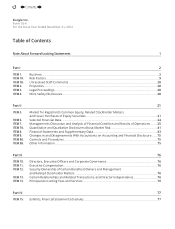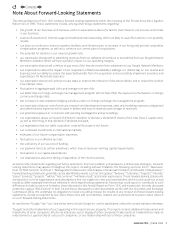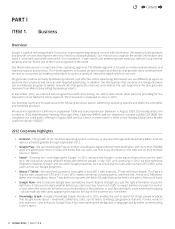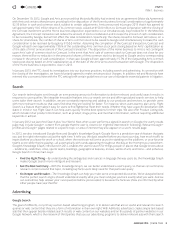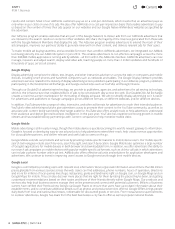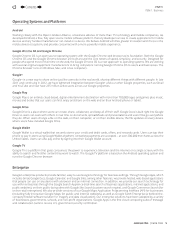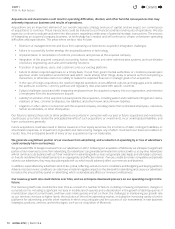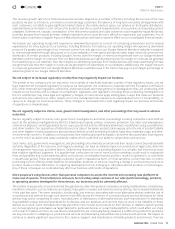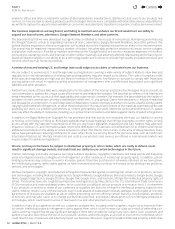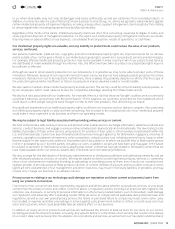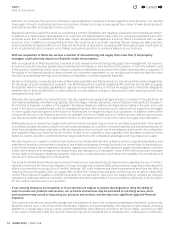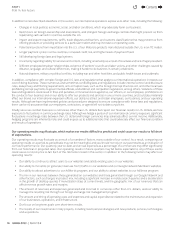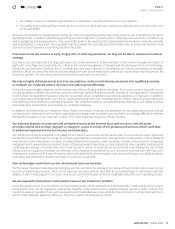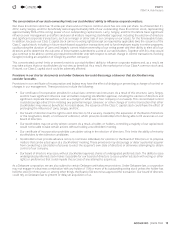Google 2012 Annual Report Download - page 15
Download and view the complete annual report
Please find page 15 of the 2012 Google annual report below. You can navigate through the pages in the report by either clicking on the pages listed below, or by using the keyword search tool below to find specific information within the annual report.
9GOOGLE INC. | Form10-K
PART I
ITEM1A.Risk Factors
ITEM1A. Risk Factors
Our operations and fi nancial results are subject to various risks and uncertainties, including those described below, which could
adversely aff ect our business, fi nancial condition, results of operations, cash fl ows, and the trading price of our common stock.
Risks Related to Our Business and Industry
We face intense competition. If we do not continue to innovate and provide products and services that are useful to
users, we may not remain competitive, and our revenues andoperating results could be adversely aff ected.
Our business is rapidly evolving and intensely competitive, and is subject to changing technologies, shifting user needs, and
frequent introductions of new products and services. Our ability to compete successfully depends heavily on providing products
and services that make using the internet a more useful and enjoyable experience for our users and delivering innovative products
and technologies to the marketplace. With our acquisition of Motorola, the competitive pressure to innovate will now encompass
a wider range of products and services, including products and services that may be outside of our historical core business.
We have many competitors in diff erent industries, including general purpose search engines, vertical search engines and
e-commerce sites, social networking sites, traditional media companies, wireless mobile device companies, and providers of online
products and services. Our current and potential competitors range from large and established companies to emerging start-
ups. Established companies have longer operating histories and more established relationships with customers and users, and
they can use their experience and resources in ways that could aff ect our competitive position, including by making acquisitions,
investing aggressively in research and development, aggressively initiating intellectual property claims (whether or not meritorious)
and competing aggressively for advertisers and websites. Emerging start-ups may be able to innovate and provide products and
services faster than we can.
Our competitors are constantly developing innovations in web search, online advertising, wireless mobile devices, and web-based
products and services. The research and development of new, technologically advanced products is also a complex and uncertain
process requiring high levels of innovation and investment, as well as the accurate anticipation of technology, market trends and
consumer needs. As a result, we must continue to invest signifi cant resources in research and development, including through
acquisitions, in order to enhance our web search technology and our existing products and services, and introduce new products
and services that people can easily and eff ectively use. If we are unable to provide quality products and services, then acceptance
rates for our products and services could decline and aff ect consumer and advertiser perceptions of our brand. In addition, these
new products and services may present new and di cult technological and legal challenges, and we may be subject to claims
if users of these off erings experience service disruptions or failures or other issues. Ouroperating results would also suff er if
our innovations are not responsive to the needs of our users, advertisers, and Google Network Members, are not appropriately
timed with market opportunities, or are not eff ectively brought to market. As technology continues to develop, our competitors
may be able to off er user experiences that are, or that are seen to be, substantially similar to or better than ours. This may force
us to compete in diff erent ways and expend signifi cant resources in order to remain competitive. If our competitors are more
successful than we are in developing compelling products or in attracting and retaining users, advertisers, and content providers,
our revenues and operating results could be adversely aff ected.
Our ongoing investment in new business strategies and new products, services, and technologies isinherently risky, and
could disrupt our ongoing businesses.
We have invested and expect to continue to invest in new business strategies, products, services, and technologies. Such endeavors
may involve signifi cant risks and uncertainties, including distraction of management from current operations, insu cient revenues
to off set liabilities assumed and expenses associated with these new investments, inadequate return of capital on our investments,
and unidentifi ed issues not discovered in our due diligence of such strategies and off erings. Because these new ventures are
inherently risky, no assurance can be given that such strategies and off erings will be successful and will not adversely aff ect our
reputation, fi nancial condition, and operating results.
4
Contents
4


